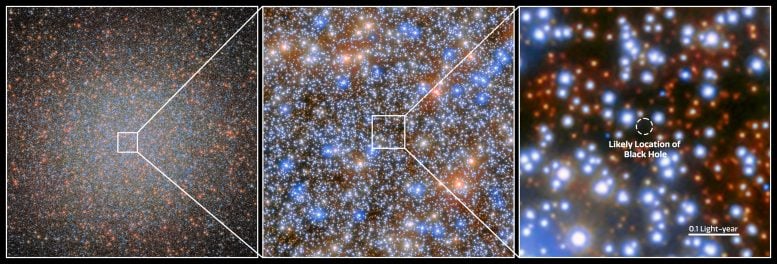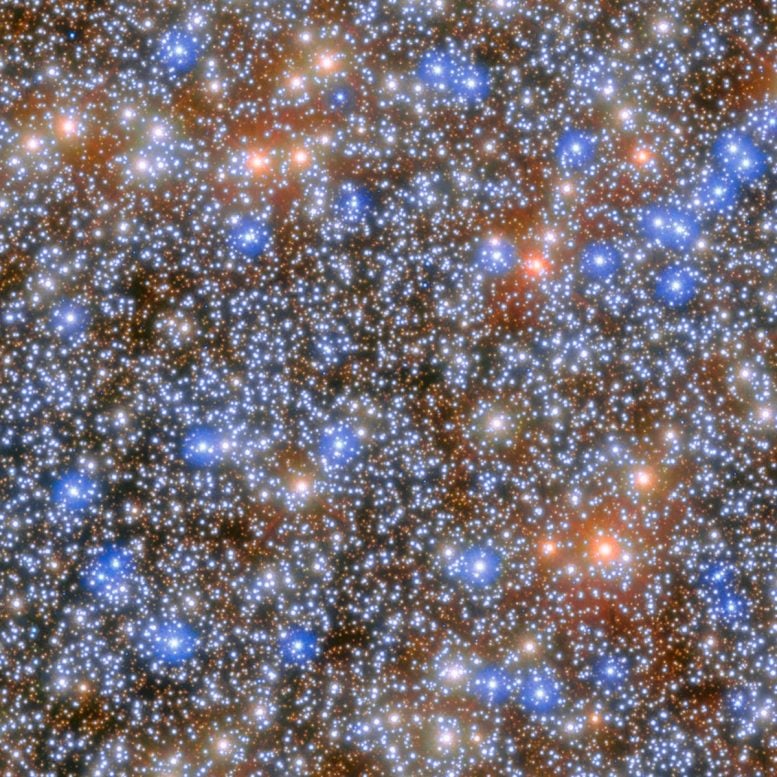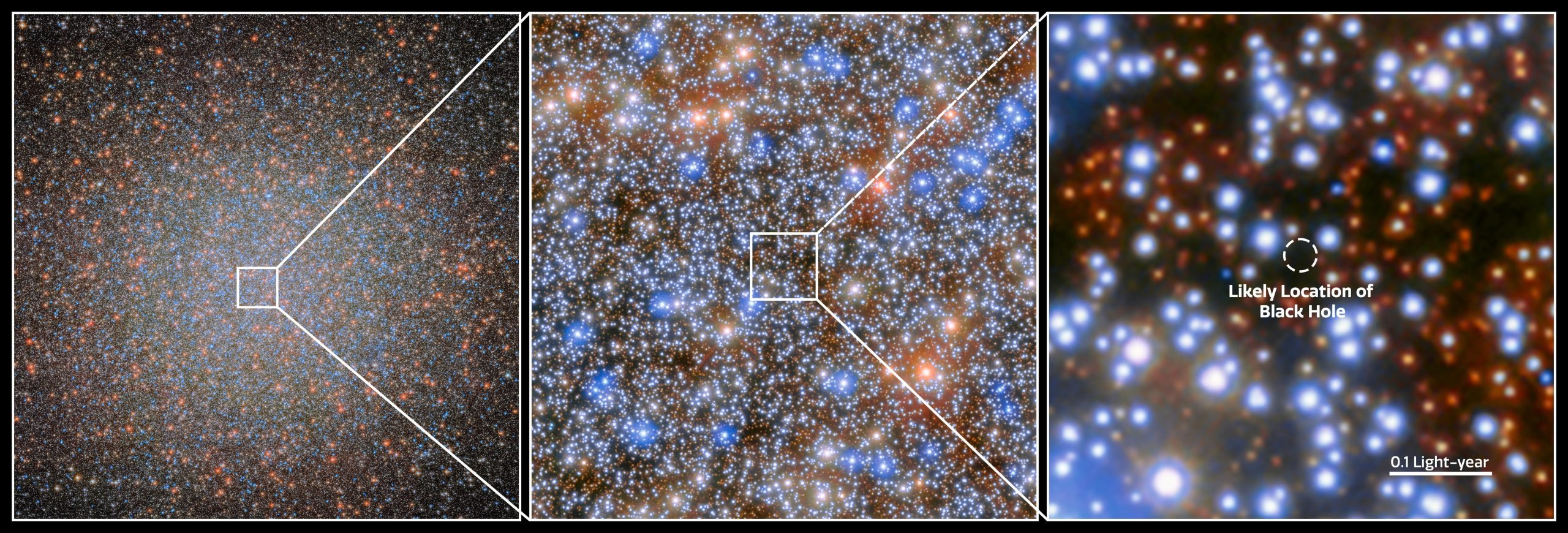An international team of astronomers has used more than 500 images from NASA’s Hubble Space Telescope – spanning two decades of observations – to detect seven fast-moving stars in the innermost region of the globular star cluster Omega Centauri, the largest and brightest globular cluster in the sky. These stars provide new compelling evidence for the presence of the gravitational pull from an intermediate-mass black hole (IMBH) tugging on them. Only a few other IMBH candidates have been found to date. Credit: ESA/Hubble, NASA, Maximilian Häberle (MPIA)
Black holes are the universe’s trap doors leading into an abyss. They normally come in two sizes. The first type are stars that are massive enough that when they burn out they collapse down to a singularity that’s equivalent to five to ten times our sun’s mass crushed into something smaller than the period at the end of this sentence.
The second known type is monster black holes that are millions or even billions of times our sun’s mass. They dwell in the dark hearts of galaxies, gobbling up any stars that pass nearby. They must be intimately tied to the early days of galaxy formation.
What’s elusive are so-called intermediate-mass black holes weighing hundreds or a few thousand solar masses. Are they a “missing link” in 
This image shows the location of the IMBH in Omega Centauri. If confirmed, at its distance of 17,700 light-years the candidate black hole resides closer to Earth than the 4.3-million-solar-mass black hole in the center of the Milky Way, which is 26,000 light-years away. Besides the Galactic center, it would also be the only known case of a number of stars closely bound to a massive black hole.
This image includes three panels. The first image at left shows the globular cluster Omega Centauri, a collection of myriad stars colored red, white, and blue on the black background of space. The second image shows the details of the central region of this cluster, with a closer view of the individual stars. The third image shows the location of the IMBH candidate in the cluster.
Credit: ESA/Hubble, NASA, Maximilian Häberle (MPIA)
Hubble Space Telescope Finds Strong Evidence for Intermediate-Mass Black Hole in Omega Centauri
Most known black holes are either extremely massive, like the supermassive black holes that lie at the cores of large galaxies, or relatively lightweight, with a mass of under 100 times that of the Sun. Intermediate-mass black holes (IMBHs) are scarce, however, and are considered rare “missing links” in black hole evolution.
Now, an international team of astronomers has used more than 500 images from 
This image shows the central region of the Omega Centauri globular cluster, where the IMBH candidate was found. Credit: ESA/Hubble, NASA, Maximilian Häberle (MPIA)
The astronomers have now created an enormous catalog for the motions of these stars, measuring the velocities for 1.4 million stars gleaned from the Hubble images of the cluster. Most of these observations were intended to calibrate Hubble’s instruments rather than for scientific use, but they turned out to be an ideal database for the team’s research efforts.
“We discovered seven stars that should not be there,” explained Maximilian Häberle of the Max Planck Institute for Astronomy in Germany, who led this investigation. “They are moving so fast that they would escape the cluster and never come back. The most likely explanation is that a very massive object is gravitationally pulling on these stars and keeping them close to the center. The only object that can be so massive is a black hole, with a mass at least 8,200 times that of our sun.”
Implications and Historical Significance of the Discovery
Several studies have suggested the presence of an IMBH in Omega Centauri. However, other studies proposed the mass could be contributed by a central cluster of stellar-mass black holes, and had suggested the lack of fast-moving stars above the necessary escape velocity made an IMBH less likely in comparison.
“This discovery is the most direct evidence so far of an IMBH in Omega Centauri,” added team lead Nadine Neumayer of the Max Planck Institute for Astronomy in Germany, who initiated the study, together with Anil Seth from the University of Utah, Salt Lake City. “This is exciting because there are only very few other black holes known with a similar mass. The black hole in Omega Centauri may be the best example of an IMBH in our cosmic neighborhood.”
If confirmed, at a distance of 17,700 light-years the candidate black hole resides closer to Earth than the 4.3-million-solar-mass black hole in the center of the Milky Way, located 26,000 light-years away.
Omega Centauri is visible from Earth with the naked eye and is one of the favorite celestial objects for stargazers living in the southern hemisphere. Located just above the plane of the Milky Way, the cluster appears almost as large as the full Moon when seen from a dark rural area. It was first listed in Ptolemy’s catalog nearly 2,000 years ago as a single star. Edmond Halley reported it as a nebula in 1677. In the 1830s the English astronomer John Herschel was the first to recognize it as a globular cluster.
The discovery paper led by Häberle et al. was published online on July 10 in the journal Nature.
Reference: “Fast-moving stars around an intermediate-mass black hole in ω Centauri” by Maximilian Häberle, Nadine Neumayer, Anil Seth, Andrea Bellini, Mattia Libralato, Holger Baumgardt, Matthew Whitaker, Antoine Dumont, Mayte Alfaro-Cuello, Jay Anderson, Callie Clontz, Nikolay Kacharov, Sebastian Kamann, Anja Feldmeier-Krause, Antonino Milone, Maria Selina Nitschai, Renuka Pechetti and Glenn van de Ven, 10 July 2024, Nature.
DOI: 10.1038/s41586-024-07511-z
The Hubble Space Telescope has been operating for over three decades and continues to make ground-breaking discoveries that shape our fundamental understanding of the universe. Hubble is a project of international cooperation between NASA and ESA (




















Discussion about this post